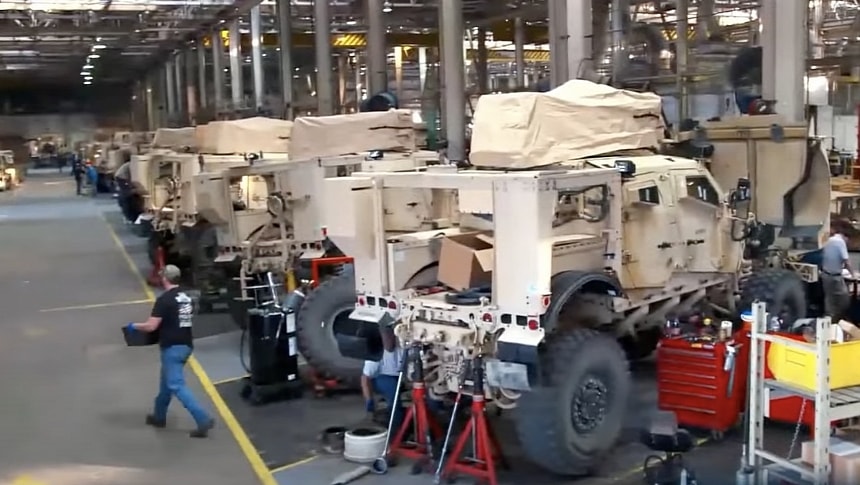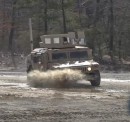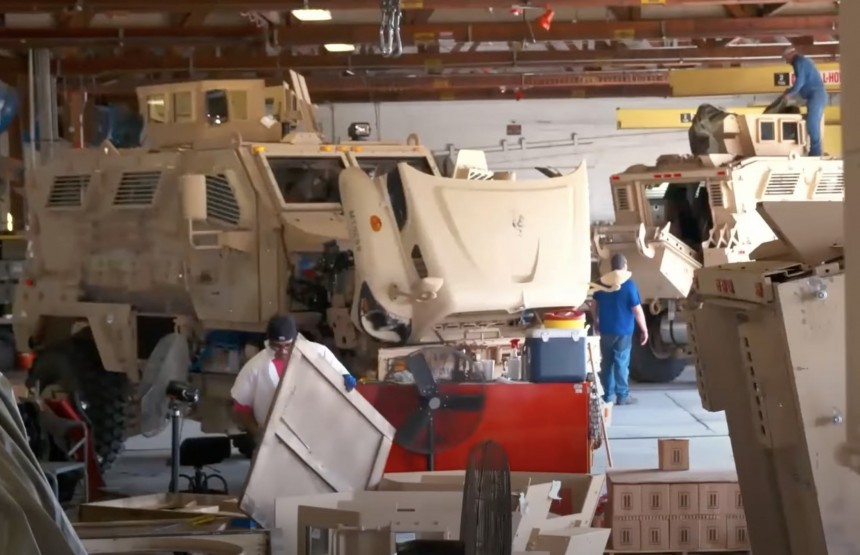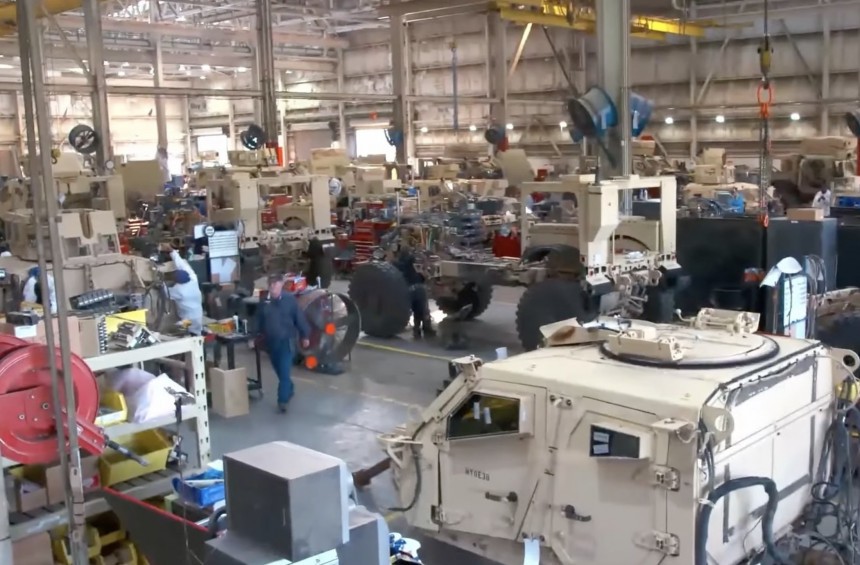Monstrously big. Rudimentarily basic. Robustly designed. A fortress on wheels. This is the HMMWV that rolls off the production line of the Red River Army Depot in Texas. The vehicles are being phased out from the frontline service. But the army still heavily relies on them. And this is how they see the light of day.
Red River Army Depot (RRAD) is the Army's Tactical Wheeled Vehicle Cite (Center of Industrial and Technical Excellence). That is where the HMMWVs are manufactured, modified, and fixed. For nearly 20 years, Red River Army Depot has been making sure that they return to the field in a like-new condition. Once completed, each armored vehicle costs around $300,000.
RRAD focuses on tactical vehicle repair and modification, with the HMMWV (High Mobility Multi-Purpose Wheeled Vehicles), affectionately called Humvees, being the main task.
Production involves machinery such as industrial-scale laser cutters, which are used to cut segments of armor plating or sheet metal for application. Laser cutters are used because they are accurate, produce much less waste, and are fast. These characteristics make them indispensable during production.
After each segment of sheet metal or armor is cut, it is transferred to a workbench. That is where the edges are refined. They must be polished properly before they are used to fasten the various turret elements during welding.
Materials are milled and drilled with the help of vertical machining centers. Punching machines are also used for metallurgical tasks such as embossing, flaming, and louvering to produce angled slats.
A computer-controlled CNC router is used to cut and shape various materials, including aluminum. It is capable of cutting aluminum blocks to form various components of the final build. In order to protect the armed forces in combat zones against ballistic attacks, everything must be impeccable.
A technician places alignment stickers on the hull of the vehicle, thus indicating the upcoming panel matching. The production team uses a high-precision structured light 3D scanner to create a 3D point cloud and polygonal mesh model of the surface geometry.
The 3D scanner scans new or repaired parts and compares the 3D data to a digital master model to make sure that there are no manufacturing flaws and that everything fits in place. The scanner is also capable of scanning sounding areas on a vehicle and then digitally testing the fit of a new component design.
It is noncontact and highly precise, with down-to-zero error hazards. When required, technicians can come up with modifications to the design of the vehicle, based on the image created by the scanner.
Production is, indeed, based on automation and safety. However, because of the tight working spaces, human hands are still required to perform jobs such as attaching nuts and bolts.
High Mobility Multi-Purpose Wheeled Vehicles (HMMWVs) are four-wheel-drive light utility military vehicles originally produced without armor protection. However, once the armor cage for the turret has been constructed, technicians have to attach it to the roof of the vehicle.
The turret integrates a gear system, which is used by the gunner to turn the turret toward the direction needed. It also incorporates sophisticated electronics and sensors, which are tested, calibrated, or updated to suit the harsh operational requirements of the US Military before they are fitted to the vehicle.
The RRAD integrates no fewer than 1,400 buildings that shelter various sections and stations reserved for various stages of production, across 15,000 acres in Hooks, Texas. With so many sections and stations on such a stretched surface, all relying on one another, every phase must go according to plan in order to prevent production lag.
Quality control is applied during all stages of production or assembly, not just when the vehicle is completed. Technicians install everything from electrical to hydraulics as the vehicle nears the final phase of assembly.
Active in combat zones since 1983, present in the Gulf War, Afghanistan, and Iraq, the Humvees are inching closer to their retirement age. Joint Light Tactical Vehicles (JLTVs) were designed as a replacement for the HMMWVs in the frontline use. They are manufactured by Oshkosh. But they are upgraded, overhauled, and repaired at RRAD.
The production center in Hooks, Texas, also manufactures AN/TWQ-1 Avenger Air Defense system turrets based on the heavy HMMWV chassis.
The HMMWVs are fitted with 37-inch tires, while the JLTVs get 40 inchers, which are refurbished and re-treated at the wheel and tire shop of the facility.
The production center is also equipped with the HMMWV Egress Assistance Trainer (HEAT). It is a roll cage used by the US Army to train its personnel to egress from rolled-over vehicles. On the frontline, getting out of a vehicle that rolled over can be a matter of life and death.
From RRAD, vehicles are deployed to operational units. They will soon be phased out and retired from the frontline. However, the ones still in existence will be used for other roles.
RRAD focuses on tactical vehicle repair and modification, with the HMMWV (High Mobility Multi-Purpose Wheeled Vehicles), affectionately called Humvees, being the main task.
Production involves machinery such as industrial-scale laser cutters, which are used to cut segments of armor plating or sheet metal for application. Laser cutters are used because they are accurate, produce much less waste, and are fast. These characteristics make them indispensable during production.
After each segment of sheet metal or armor is cut, it is transferred to a workbench. That is where the edges are refined. They must be polished properly before they are used to fasten the various turret elements during welding.
A computer-controlled CNC router is used to cut and shape various materials, including aluminum. It is capable of cutting aluminum blocks to form various components of the final build. In order to protect the armed forces in combat zones against ballistic attacks, everything must be impeccable.
A technician places alignment stickers on the hull of the vehicle, thus indicating the upcoming panel matching. The production team uses a high-precision structured light 3D scanner to create a 3D point cloud and polygonal mesh model of the surface geometry.
The 3D scanner scans new or repaired parts and compares the 3D data to a digital master model to make sure that there are no manufacturing flaws and that everything fits in place. The scanner is also capable of scanning sounding areas on a vehicle and then digitally testing the fit of a new component design.
It is noncontact and highly precise, with down-to-zero error hazards. When required, technicians can come up with modifications to the design of the vehicle, based on the image created by the scanner.
Production is, indeed, based on automation and safety. However, because of the tight working spaces, human hands are still required to perform jobs such as attaching nuts and bolts.
The turret integrates a gear system, which is used by the gunner to turn the turret toward the direction needed. It also incorporates sophisticated electronics and sensors, which are tested, calibrated, or updated to suit the harsh operational requirements of the US Military before they are fitted to the vehicle.
The RRAD integrates no fewer than 1,400 buildings that shelter various sections and stations reserved for various stages of production, across 15,000 acres in Hooks, Texas. With so many sections and stations on such a stretched surface, all relying on one another, every phase must go according to plan in order to prevent production lag.
Quality control is applied during all stages of production or assembly, not just when the vehicle is completed. Technicians install everything from electrical to hydraulics as the vehicle nears the final phase of assembly.
Active in combat zones since 1983, present in the Gulf War, Afghanistan, and Iraq, the Humvees are inching closer to their retirement age. Joint Light Tactical Vehicles (JLTVs) were designed as a replacement for the HMMWVs in the frontline use. They are manufactured by Oshkosh. But they are upgraded, overhauled, and repaired at RRAD.
The production center in Hooks, Texas, also manufactures AN/TWQ-1 Avenger Air Defense system turrets based on the heavy HMMWV chassis.
The production center is also equipped with the HMMWV Egress Assistance Trainer (HEAT). It is a roll cage used by the US Army to train its personnel to egress from rolled-over vehicles. On the frontline, getting out of a vehicle that rolled over can be a matter of life and death.
From RRAD, vehicles are deployed to operational units. They will soon be phased out and retired from the frontline. However, the ones still in existence will be used for other roles.









